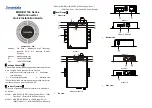
SIEPCYEUOQ2V01A Q2V Technical Manual
233
Code
Name
Causes
Possible Solutions
oL7
High Slip Braking Overload
The load inertia is too large.
An external force on the load side rotated the motor.
Something is preventing deceleration on the load
side.
•
Decrease deceleration times in
C1-02, C1-04, C1-06, and C1-
08 [Deceleration Times]
for applications that do not use High
Slip Braking.
•
Use a braking resistor to decrease the deceleration time.
The value set in
n3-04 [HSB Overload Time]
is too
small.
•
Increase the value set in
n3-04
.
•
Connect a thermal overload relay to the motor, and set
n3-04 =
1200 s (maximum value)
.
Note:
•
The drive detects this fault if the output frequency is constant for longer than
n3-04
.
•
Do a Fault Reset to clear the fault.
Code
Name
Causes
Possible Solutions
oPr
Keypad Connection Fault
The keypad is not securely connected to the
connector on the drive.
Examine the connection between the keypad and the drive.
The connection cable between the drive and the
keypad is disconnected.
•
Remove the keypad and then reconnect it.
•
Replace the cable if damaged.
Note:
•
The drive detects this fault if these conditions are correct:
–
o2-06 = 1 [Keypad Disconnect Detection = Enabled]
.
–
b1-02 = 0 [Run Comm. Sel 1 = Keypad]
, or the drive is operating in LOCAL Mode with the keypad.
•
Do a Fault Reset to clear the fault.
Code
Name
Causes
Possible Solutions
oS
Overspeed
There is overshoot.
•
Decrease
C5-01 [ASR PGain 1]
and increase
C5-02 [ASR
ITime 1]
.
•
Use
H6-02 to H6-05 [Pulse Train Input Setting Parameters]
to
adjust the pulse train gain.
There is an incorrect number of PG pulses set in the
drive.
Set
H6-02 [PI Frequency Scale]
to the pulse train frequency
during 100% reference (maximum motor rotation speed).
The
oS
detection level is set incorrectly.
Adjust
F1-08 [Overspeed Level]
and
F1-09 [Overspeed Delay
Time]
.
If the drive detects the fault at start or in the low
speed range (10% or less) and
n8-57 = 1 [High-
Freq Injection = Enabled]
for PM Control methods,
the high frequency injection gain is too high.
•
Set
E5-xx [PM Motor Parameters]
correctly or do Rotational
Auto-Tuning.
•
Decrease the value of
n8-41 [HFI PoleDet Pgain]
in 0.5 unit
increments.
Note:
Set
n8-41 > 0.0
for IPM motors.
Note:
•
The drive detects this fault if the motor speed is more than the value set in
F1-08
for longer than
F1-09
.
•
Do a Fault Reset to clear the fault.
•
If the drive detects this fault, it will operate the motor as specified by the Stopping Method set in
F1-03 [Overspeed Detection Selection]
.
Code
Name
Causes
Possible Solutions
ov
Overvoltage
The deceleration time is too short and too much
regenerative energy is flowing back into the drive.
•
Increase the values set in
C1-02, C1-04, C1-06, or C1-08
[Deceleration Times]
.
•
Connect a dynamic braking option to the drive.
•
Perform Deceleration Rate Tuning.
The acceleration time is too short.
•
Make sure that sudden drive acceleration does not cause the
fault.
•
Increase the values set in
C1-01, C1-03, C1-05, or C1-07
[Acceleration Times]
.
•
Increase the value set in
C2-02 [Jerk@End of Accel]
.
•
Set
L3-11 = 1 [Overvolt Supression Select = Enabled]
.
The braking load is too large.
Connect a dynamic braking option to the drive.
There are surge voltages in the input power supply
Connect a DC reactor to the drive.
Note:
If you turn the phase advancing capacitors ON and OFF and
use thyristor converters in the same power supply system,
there can be surge voltages that irregularly increase the input
voltage.
The drive output cable or motor is shorted to ground
(the current short to ground is charging the main
circuit capacitor of the drive through the power
supply).
1.
Examine the motor main circuit cable, terminals, and motor
terminal box, and then remove ground faults.
2.
Re-energize the drive.
If the drive detects ov in these conditions, the speed
search-related parameters are incorrect.
•
During speed search
•
During momentary power loss recovery
•
When the drive starts again automatically
•
Examine the settings for all speed search related parameters.
•
Set
b3-19 ≠ 0 [Speed Retry Times ≠ 0 times]
.
•
Adjust
b3-03 [SpSrch Deceleration Time]
.
•
Do Stationary Auto-Tuning for Line-to-Line Resistance and
then set
b3-24 = 1 [SpSrch Method Selection = Speed
Estimation]
.
The power supply voltage is too high.
Decrease the power supply voltage to match the drive rated
voltage.
Summary of Contents for Q2V Series
Page 2: ...This Page Intentionally Blank 2 SIEPCYEUOQ2V01A Q2V Technical Manual...
Page 12: ...12 SIEPCYEUOQ2V01A Q2V Technical Manual...
Page 18: ...i 2 Legal Information 18 SIEPCYEUOQ2V01A Q2V Technical Manual...
Page 26: ...1 2 Features and Advantages of Control Methods 26 SIEPCYEUOQ2V01A Q2V Technical Manual...
Page 38: ...2 8 Installation Methods 38 SIEPCYEUOQ2V01A Q2V Technical Manual...
Page 70: ...3 3 Main Circuit Wiring 70 SIEPCYEUOQ2V01A Q2V Technical Manual Models B006 B012...
Page 102: ...3 17 Motor Application Precautions 102 SIEPCYEUOQ2V01A Q2V Technical Manual...
Page 138: ...4 12 Test Run Checklist 138 SIEPCYEUOQ2V01A Q2V Technical Manual...
Page 144: ...5 2 European Standards 144 SIEPCYEUOQ2V01A Q2V Technical Manual...
Page 145: ...Standards Compliance 5 5 2 European Standards SIEPCYEUOQ2V01A Q2V Technical Manual 145...
Page 146: ...5 2 European Standards 146 SIEPCYEUOQ2V01A Q2V Technical Manual...
Page 266: ...7 10 Troubleshooting Without Fault Display 266 SIEPCYEUOQ2V01A Q2V Technical Manual...
Page 284: ...8 6 Storage Guidelines 284 SIEPCYEUOQ2V01A Q2V Technical Manual...
Page 312: ...10 10 Peripheral Devices and Options 312 SIEPCYEUOQ2V01A Q2V Technical Manual...
Page 430: ...11 21 Parameters Changed by PM Motor Code Selection 430 SIEPCYEUOQ2V01A Q2V Technical Manual...
Page 731: ...SIEPCYEUOQ2V01A Q2V Technical Manual 731 Z Z pulse Auto Tuning 125...
















































